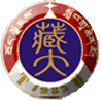Tibet Arts & CultureTibetans share their region and unique culture with Menpa, Luopa, Han Chinese, Hui, Sherpa, and a few Deng people. Tibetans are optimistic and happy people. So simply being in Tibet is a cultural experience in itself. However, if that is not enough, Tibet offers many opportunities to explore and learn about it's unique culture. There are plenty of museums, theatres, operas, and galleries to keep the culturally inclined people very busy.
Presenting Hada (or Khatag) is traditional practice of respect and hospitality in Tibet.If people are presenting a Hada to a statue or a high lama, he/she should raise the Hada above his/her's shoulders and bow.When ordinary people receive a Hada, it is proper to accept it with both their hands.Always add a "La" after one's name to show your respect, for example Tashi La.Address a high lama with "Rinpoche La" and a common lama with "Geshe La", even though he might not be a Geshe. There are some common rules to remember if people plan to visit a monastery.Always walk clockwise around the religious shrines, stupas, Mani stones and prayer wheels.However, if people visit a Bon monastery, then walk counterclockwise. Although the monks remove their shoes upon entering a chamber, it is acceptable to enter a chamber without removing visitors' shoes.Coming inside during the chanting session is permissible.Sit or stand in the rear, with no loud and irreverent conversation . Also, it is considered proper etiquette to offer some money while visiting a monastery. The following are considered taboo:
Drupthok Thangthong Gyalpo organized the first performance with the help of seven pretty girls to raise fund to build bridges in order to improve transportation and facilitate pilgrimage.The tradition was passed down and developed into Tibetan opera, popular throughout the region. Usually performances were held on various festive occasions, such as Shoton, in the session in which professional and amateur troupes are summoned to Lhasa to entertain the Dalai Lama and monks in Potala, Drepung or Norbulingka. Buddhist teachings and Tibetan history are the sources of Tibetan Opera's inspiration, so most of its repertoire is based on Buddhist stories and Tibetan history.The traditional drama is a combination of dances, chants, songs, and masks.
A Tibetan opera performance follows fixed procedures.Each performance begins with the purification of the stage and a blessing to the God.A narrator sings a summary of the story in verse.Then performers enter and start dancing and singing.The performance ends with a ritual of blessing.
Thangka generally falls into several categories according to the techniques involved; namely painted Thangka, weaving Thangka, embroidery Thangka, paster Thangka, and so on.Among them, painted Thangkas are most commonly seen.Thangka appeared around the tenth century, as a combination of Chinese scroll painting, Nepal painting and Kashmir painting. Thangkas are usually placed upright in a rectangular shape while there are a few that deals with subjects of Mandala that are square.Cotton canvas and linen cloth are the common fabrics on which pictures are painted on with mineral and organic pigments, but important Thangkas use ground gold and gemstones as pigments. A typical Thangka has a printed or embroidered picture mounted on a piece of colorful silk.A wooden stick is attached on the side from the bottom to the top to make it easier to hang and roll up.Thangkas cover various subjects including Tibetan astrology, pharmacology, theology, Mandala, images of great adepts, deities and Buddhas, and Jataka stories of the Buddha. Painting a Thangka usually starts by stretching a piece of cotton cloth on a wooden frame along its sides.Then, a certain type of gesso is spread over both the front and back of the canvas to block the holes and then scraped off to produce smooth surfaces.Afterwards, some orienting lines are drawn to guide the sketching.By following a fixed proportion, images are then roughly drawn.The featured deity or saint occupies the center while other attendant deities or monks surround the central figure and along the border, and is comparatively smaller in size. Next is coloring.Painters apply pigments on the sketch.Black, green, red, yellow and white are the basic colors used in coloring.Shading is then done to produce better pictorial effects.At the final stage, facial features and eyes are finished, which is sacredly done only after a ritual held on a fixed day.After detail finishes, the canvas is removed from the frame and mounted on a piece of brocaded silk.The wooden sticks are attached to the top and bottom of the silk.After a dust cover of gossamer silk is attached it is ready to be hung up.Karma Gadri tradition and Menri Karma Gadri tradition are the two major schools of Tibetan Thangka Painting.
The ingredients of butter tea are butter, brick tea, and salt.In every Tibetan family, there is a slim wooden cylinder which is used for churning up tea.A wooden piston is used to push and pull inside the cylinder where butter, salt, and freshly-brewed brick tea are mixed.After a minute or two of mixing it is poured into a kettle, so that it can be kept warm over a fire, and be ready for serving at any time. Tea churning is a daily ritual for Tibetans.They are accustomed to finish several bowlfuls of butter tea before starting to work for a day.Butter tea is also served to guests.Generally speaking, guest cannot decline with thanks but have to drink at least three bowlfuls of butter tea before leaving.In order to show courtesy to ones' host, the tea should be taken slowly and meanwhile tell the host that the tea tastes wonderful.It is customary to leave a little at the bottom of tea cup when finished. Tibetans like drinking tea very much.Besides salted butter tea, sweet milk tea is another popular alternative, especially at Tibetan wedding feasts.Hot boiling black tea filtered and decanted into a churn, fresh milk and sugar are then added.After about a minute of churning the tea will be ready for serving and a cup of reddish white drink will turn up in front of you.
Tibetan people build these unique works of art to show their piety to their deities and the Buddha's teachings.Upon encountering a mani stone mound, Tibetan people circumambulate it clockwise as a prayer offering for health, peace, and protection.
Stupa burial and cremation are reserved for high lamas who are being honored in death.Sky burial is the usual means for disposing of the corpses of commoners.Sky burial is not considered suitable for children who are less than 18, pregnant women, or those who have died of infectious disease or accident.The origin of sky burial remains largely hidden in Tibetan mystery. Sky burial is a ritual that has great religious meaning.Tibetans are encouraged to witness this ritual, to confront death openly and to feel the impermanence of life.Tibetans believe that the corpse is nothing more than an empty vessel.The spirit, or the soul, of the deceased has exited the body to be reincarnated into another circle of life.It is believed that the Drigung Kagyu order of Tibetan Buddhism established the tradition in this land of snow, although there are other versions of its origin. The corpse is offered to the vultures.It is believed that the vultures are Dakinis.Dakinis are the Tibetan equivalent of angels.In Tibetan, Dakini means "sky dancer".Dakinis will take the soul into the heavens, which is understood to be a windy place where souls await reincarnation into their next lives.This donation of human flesh to the vultures is considered virtuous because it saves the lives of small animals that the vultures might otherwise capture for food.Sakyamuni, one of the Buddhas, demonstrated this virtue.To save a pigeon, he once fed a hawk with his own flesh. After death, the deceased will be left untouched for three days.Monks will chant around the corpse.Before the day of sky burial, the corpse will be cleaned and wrapped in white cloth.The corpse will be positioned in a fetal position, the same position in which the person had been born.The ritual of sky burial usually begins before dawn.Lamas lead a ritual procession to the charnel ground, chanting to guide the soul.There are few charnel grounds in Tibet.They are usually located near monasteries.Few people would visit charnel grounds except to witness sky burials.Few would want to visit these places. After the chanting, the body breakers prepare the body for consumption by the vultures.The body is unwrapped and the first cut is made on the back.Hatchets and cleavers are used to quickly cut the body up, in a definite and precise way.Flesh is cut into chunks of meat.The internal organs are cut into pieces.Bones are smashed into splinters and then mixed with tsampa, roasted barley flour. As the body breakers begin, juniper incense is burned to summon the vultures for their tasks, to eat breakfast and to be Dakinis.During the process of breaking up the body, those ugly and enormous birds circle overhead, awaiting their feast.They are waved away by the funeral party, usually consisting of the friends of the deceased, until the body breakers have completed their task.After the body has been totally separated, the pulverized bone mixture is scattered on the ground.The birds land and hop about, grabbing for food.To assure ascent of the soul, the entire body of the deceased should be eaten.After the bone mixture, the organs are served next, and then the flesh. This mystical tradition arouses curiosity among those who are not Tibetan.However, Tibetans strongly object to visits by the merely curious.Only the funeral party will be present at the ritual.Photography is strictly forbidden.Tibetans believe that photographing the ritual might negatively affect the ascent of the soul.
Tibetan people believe that making tsatsas is a merit accumulating action.As holy objects, tsatsas can be found inside stupas, prayer wheel niches, holy caves and monastery altars or beside holy mountains, holy lakes and other holy sites.Small tsatsas can be put inside a portable amulet shrine (called Gau in Tibetan) and taken as amulets by those traveling.Making tsatsa is a compulsory skill of monks in Tibetan monasteries. Tsatsas fall into different categories in accordance with ingredients added, including plain clay tsatsa, which has no special ingredient; ash tsatsa, which has ashes of late lamas added; medicine tsatsa, which has Tibetan herbs added; humoral tsatsa, which contains liquid produced in the mummifying procedure of late high lamas; and tsatsa made by high lamas themselves or other celebrities.In addition, however, there are some virtual tsatsas made. Lucky travelers may find in some region that Tibetans are using their tsatsa moulds stamping in wind, water and fire! Tibetan people believe everything can be used to make the holy object, even wind, water and fire.After tsatsas have been molded, they are dried or fired to be hard.Only after having been ritually empowered can they be used as holy objects!
Prayer Flag
Prayer flags are actually colorful cotton cloth squares in white, blue, yellow, green, and red.Woodblocks are used to decorate the prayer flags with images, mantras, and prayers.Usually at the center of a prayer flag, there is an image of the Wind Horse which bears the Three Jewels of Buddhism.On the four corners of the flag, are images of Garuda, Dragon, Tiger, and Snow Lion which are the four sacred animals representing the four virtues of wisdom, power, confidence, and fearless joy respectively. Sometimes auspicious Buddhist symbols can be found on the edges.In the blank spaces between the images, prayers and mantras are printed.
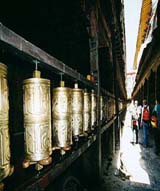
Prayer Wheel
Tibetans use prayer wheels to spread spiritual blessings to all sentient beings and invoke good karma in their next life.They believe that every rotation of a prayer wheel equals one utterance of the mantra, thus the religious practice will in return help them accumulate merits, replace negative effects with positive ones, and hence bring them good karma. The religious exercise is part of Tibetan life.People turn the wheel day and night while walking or resting, whenever their right hands are free while murmuring the same mantra.Buddhists turn the wheel clockwise.Bon followers turn the wheel counter clockwise. Prayer wheels vary in size and type.Not all prayer wheels are hand held.It is common for bucket-sized prayer wheels to be lined up on wooden racks along walking paths circling monasteries and other sacred sites, for the benefit of visiting pilgrims.Larger water, fire, and wind prayer wheels are built so that they are empowered by the flowing water, the flaming light, and the blowing wind which drive them, and can later pass their positive karma to all who touch them. Tibetan Buddhism Religious Symbols It is common to see various religious symbols when traveling in Tibetan monasteries and villages.They are used as sacred adornments.The Eight Auspicious Signs, or eight motifs, generally symbolize how to progress along the Buddhist path.Following are some objects that carry special symbolic meaning to the Tibetans:
|

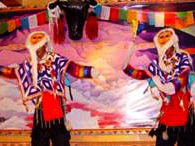 Tibetan opera, Ace Lhamo or Lhamo, which means Fairy in Tibetan,
is the traditional opera of Tibet.It is said that this opera
was created by Drupthok Thangthong Gyalpo, a monk and ridge builder
in the 14th century.
Tibetan opera, Ace Lhamo or Lhamo, which means Fairy in Tibetan,
is the traditional opera of Tibet.It is said that this opera
was created by Drupthok Thangthong Gyalpo, a monk and ridge builder
in the 14th century.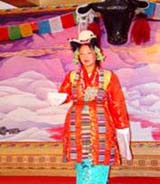 The highlight of Lhamo is its mask.Usually on the forehead
of the mask there is a motif of the Sun and Moon.From the mask,
the role of the player can be identified.A red mask refers
to the King; a green the queen; a yellow lamas and deities, etc.
The highlight of Lhamo is its mask.Usually on the forehead
of the mask there is a motif of the Sun and Moon.From the mask,
the role of the player can be identified.A red mask refers
to the King; a green the queen; a yellow lamas and deities, etc.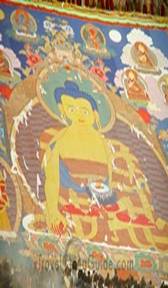 Thangka, seen in every monastery and family shrine in Tibet,
is actually a kind of Tibetan scroll banner painting and is a
unique type of art that belongs to the Tibetan culture.
Thangka, seen in every monastery and family shrine in Tibet,
is actually a kind of Tibetan scroll banner painting and is a
unique type of art that belongs to the Tibetan culture.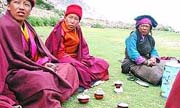 Tibetan butter tea is the indispensable beverage of everyday life
for the Tibetan people.It is good for people in many ways: to
help keep body warm, allay one's hunger, aid digestion, promote
a healthy cardiovascular system, cleanse the body of accumulated
lactic acid, and rejuvenate inner strength and increase stamina.
Tibetan butter tea is the indispensable beverage of everyday life
for the Tibetan people.It is good for people in many ways: to
help keep body warm, allay one's hunger, aid digestion, promote
a healthy cardiovascular system, cleanse the body of accumulated
lactic acid, and rejuvenate inner strength and increase stamina.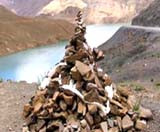 Travelers to Tibet may find mani stones and mani stone mounds
almost everywhere, in monasteries, beside villages, along paths
and on mountains.Sometimes they are decorated with sheep and
yak horns.Usually the universal mantra, Om Mani Padme Hum, is
inscribed on these smooth stone plates, pebbles and rocks.Images
of deities and great adepts and sutra texts are also common themes.
Travelers to Tibet may find mani stones and mani stone mounds
almost everywhere, in monasteries, beside villages, along paths
and on mountains.Sometimes they are decorated with sheep and
yak horns.Usually the universal mantra, Om Mani Padme Hum, is
inscribed on these smooth stone plates, pebbles and rocks.Images
of deities and great adepts and sutra texts are also common themes.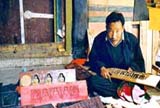 Tsatsa, with its origin in Sanskrit, is a typical Tibetan Buddhist
art form.Actually tsatsas are votive tablets in Tibetan Buddhism,
usually clay impressions made with a metal mould containing hollowed,
reversed image of a deity, a stupa or other sacred symbols.
Tsatsa, with its origin in Sanskrit, is a typical Tibetan Buddhist
art form.Actually tsatsas are votive tablets in Tibetan Buddhism,
usually clay impressions made with a metal mould containing hollowed,
reversed image of a deity, a stupa or other sacred symbols.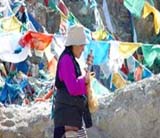 The fluttering prayer flags can often be found along with piles
of mani stones on rooftops, mountain passes, river crossings, and
other sacred places.
The fluttering prayer flags can often be found along with piles
of mani stones on rooftops, mountain passes, river crossings, and
other sacred places.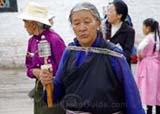 There are two kinds of prayer flags, the horizontal ones called
Lungta in Tibetan and the vertical ones called Darchor.Horizontal
prayer flags are squares connected at the top edges with a long
thread.The less used vertical prayer flags are usually single
squares or groups of squares sewn on poles which are planted in
the ground or on rooftops.
There are two kinds of prayer flags, the horizontal ones called
Lungta in Tibetan and the vertical ones called Darchor.Horizontal
prayer flags are squares connected at the top edges with a long
thread.The less used vertical prayer flags are usually single
squares or groups of squares sewn on poles which are planted in
the ground or on rooftops.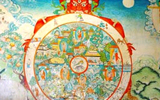 Prayer wheels, called Chokhor in Tibetan, are very common religious
objects in Tibet.A hand held prayer wheel is a hollow wooden
or metal cylinder attached to a handle.Om Mani Padme Hung mantras
are printed or etched in relief on the cylinder.Attached to the
cylinder is a lead weight with a chain, which facilitates the rotation.
Prayer wheels, called Chokhor in Tibetan, are very common religious
objects in Tibet.A hand held prayer wheel is a hollow wooden
or metal cylinder attached to a handle.Om Mani Padme Hung mantras
are printed or etched in relief on the cylinder.Attached to the
cylinder is a lead weight with a chain, which facilitates the rotation.